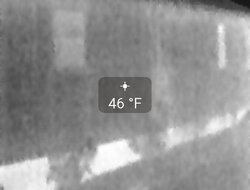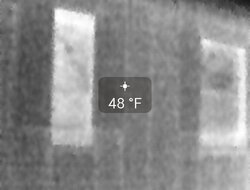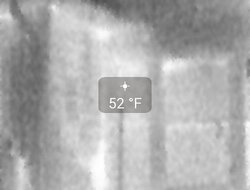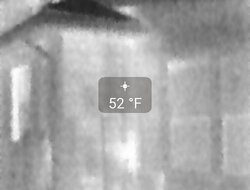Have a poorly insulated block house. It's over a crawl space, except for the converted sunroom, which is large and over a slab. I keep it at 42' in the winter, and have to heat it up and keep it heated with the insert, which is a challenge. Once warm, I can keep the place warm if I'm tending the stove religiously. But I'll drop 10' overnight on a coldish for here (low 20's) night, even on a fresh 11p reload (about 4 hours of good heat output). Found a place that had no ceiling insulation using my seek camera (cool!). Most of the rest of the ceiling had 6" of batt/cellulose (rock wool?) insulation. I blew enough fiberglass up there to get it to R-40 - 50 range. In the sunroom, I couldn't access the attic directly. Removed some A/C ducts and blew in as much as I could. $500 investment (which will likely never pay off). However, I'm hoping that it makes the house easier to heat and more comfortable. I have an ecobee t-stat with all of last year's indoor v outdoor temps, so I should be able to get a pretty objective idea of whether or not this makes a difference in heat retention, esp at night. This makes the geek in me excited. Wondering if anyone here has done the same?
Lets see how my new insulation does...
- Thread starter nola mike
- Start date
-
Active since 1995, Hearth.com is THE place on the internet for free information and advice about wood stoves, pellet stoves and other energy saving equipment.
We strive to provide opinions, articles, discussions and history related to Hearth Products and in a more general sense, energy issues.
We promote the EFFICIENT, RESPONSIBLE, CLEAN and SAFE use of all fuels, whether renewable or fossil.
You are using an out of date browser. It may not display this or other websites correctly.
You should upgrade or use an alternative browser.
You should upgrade or use an alternative browser.
- Status
- Not open for further replies.
Insulation, sealing and good glass all help. So does putting a layer of insulation over the slab, even if it is just foam underlayment.
42 degrees! Really? My refrigerator is not much colder than that.
42 degrees! Really? My refrigerator is not much colder than that.
guess I should mention it's a vacation house. 42'' when I'm not there. Then I crank the stove and hope that it gets warm enough quick enough to keep the missus from bitchingInsulation, sealing and good glass all help. So does putting a layer of insulation over the slab, even if it is just foam underlayment.
42 degrees! Really? My refrigerator is not much colder than that.
If it makes it more comfortable to spend time there it was worth it!
I just gutted and foamed in/sealed 2" panels in the family cabin. When I brought the wife up last weekend to help me hang some drywall she remarked how much warmer she felt. That makes it well worth the effort.
It'll also help with the heat in the summer!
I just gutted and foamed in/sealed 2" panels in the family cabin. When I brought the wife up last weekend to help me hang some drywall she remarked how much warmer she felt. That makes it well worth the effort.
It'll also help with the heat in the summer!
iluvjazznjava
Member
If you are going to keep the place for the long haul, then insulation upgrades (even small ones) will be worth it for comfort, even if not for savings $. If you really want to make the house comfortable in winter it sounds like you have to address those block walls and possibly the floor. Can you use foam board on either the inside or the outside of the block wall? Or build a stud wall against the block wall with more traditional fibreglass or mineral wool batts?
velvetfoot
Minister of Fire
I used my Ecobee info from last year recently as well to look at setback recovery during cold snaps. Handy.
Outside maybe. There is some foam board at least in places under the vinyl siding, so my R value there should be at least 4.5 if 1/2" board was used. I insulated the exterior wall when I redid the bathroom so R-13+ for about 1/3 of that wall. One of the walls is mostly sliding glass doors, so SOL there (30' wall). Addition on the back (master bedroom) appears framed, and I saw insulation in the wall here. Assuming it's R-13 as well, and 2 1/2 of the walls there are exterior. Some of the other rooms with exterior walls aren't used/closed off during the winter, so I'm probably doing a bit better than I think. I'll get a better idea when I throw the IR camera on them this winterIf you really want to make the house comfortable in winter it sounds like you have to address those block walls and possibly the floor. Can you use foam board on either the inside or the outside of the block wall? Or build a stud wall against the block wall with more traditional fibreglass or mineral wool batts?

I've thought about a temporary floor in the winter over the slab section (10 x 30")--maybe 1-2" foam sections with a vinyl tile overlay or something. It certainly isn't feasible to reframe anything. Again, we're talking a (primarily) summer house in VA, maybe 20 days heat/year, and usually not below the low 20's at night. Between the stove and the insulation so far, I'd have to live to 100 to get a payback on my investments.
iluvjazznjava
Member
Sounds like you have some challenges given the unique layout of the place, but looks like you at least have a handle on what has been done and where you can improve. Other than insulation, biggest factor in retaining heat is air sealing, so maybe consider penetrations in the building envelope where you have significant air leakage and work on sealing them. I put a lot of canned spray foam into the penetrations around dryer ducts, air intakes, etc. on my house and it made a noticeable difference.Outside maybe. There is some foam board at least in places under the vinyl siding, so my R value there should be at least 4.5 if 1/2" board was used. I insulated the exterior wall when I redid the bathroom so R-13+ for about 1/3 of that wall. One of the walls is mostly sliding glass doors, so SOL there (30' wall). Addition on the back (master bedroom) appears framed, and I saw insulation in the wall here. Assuming it's R-13 as well, and 2 1/2 of the walls there are exterior. Some of the other rooms with exterior walls aren't used/closed off during the winter, so I'm probably doing a bit better than I think. I'll get a better idea when I throw the IR camera on them this winter
I've thought about a temporary floor in the winter over the slab section (10 x 30")--maybe 1-2" foam sections with a vinyl tile overlay or something. It certainly isn't feasible to reframe anything. Again, we're talking a (primarily) summer house in VA, maybe 20 days heat/year, and usually not below the low 20's at night. Between the stove and the insulation so far, I'd have to live to 100 to get a payback on my investments.
Yeah, tough part about that is that I don't know if there are any penetrations under the siding that I don't know about. When I redid the bathroom, I found an old window behind the wall that had been covered with siding on one side, and drywall on the other. Other than that, big hole in the wall. I've sealed all the penetrations through the floor, and as many as I could find in the attic. Also have done all the outlets, and replaced the zillion can lights with airtight housings. And don't get me started about the skylight right in front of the stove...Sounds like you have some challenges given the unique layout of the place, but looks like you at least have a handle on what has been done and where you can improve. Other than insulation, biggest factor in retaining heat is air sealing, so maybe consider penetrations in the building envelope where you have significant air leakage and work on sealing them. I put a lot of canned spray foam into the penetrations around dryer ducts, air intakes, etc. on my house and it made a noticeable difference.
Where2
Feeling the Heat
Yeah, tough part about that is that I don't know if there are any penetrations under the siding that I don't know about. ...I've sealed all the penetrations through the floor, and as many as I could find in the attic.
When the IR camera you mentioned you intend to use in post #7 comes out, it will help you see what appears invisible otherwise. IR signatures will help you find where more of your $$$ is leaking out the walls.
Finally got down there and fired it up, used the SEEK IR. I thought I took a bunch of pics, but I can't find them for some reason. What I ended up with:
There's still 2 spots on my kitchen ceiling that light up. Much smaller than before, but maybe I missed a couple of spots towards the edge. I'll recheck at some point. Got to thinking that all I'm doing is looking for variations in insulation, rather than whether it's adequate. Oh well. Other interesting spots:
About 10 feet along 2 walls, in what is affectionately known as the "cold room". Same IR signature as my windows (which are energy efficient/gas double pane, though I don't know the R value). One of the other windows is old school single pane, and that lit up big time. So a bit of work still to do, but I guess not bad overall. I'll try to post the pics if I find them, or else take some more.
Oh, and I also saw a deer (or bigfoot, not sure) moving around in the woods across the street...
There's still 2 spots on my kitchen ceiling that light up. Much smaller than before, but maybe I missed a couple of spots towards the edge. I'll recheck at some point. Got to thinking that all I'm doing is looking for variations in insulation, rather than whether it's adequate. Oh well. Other interesting spots:
About 10 feet along 2 walls, in what is affectionately known as the "cold room". Same IR signature as my windows (which are energy efficient/gas double pane, though I don't know the R value). One of the other windows is old school single pane, and that lit up big time. So a bit of work still to do, but I guess not bad overall. I'll try to post the pics if I find them, or else take some more.
Oh, and I also saw a deer (or bigfoot, not sure) moving around in the woods across the street...
Last edited by a moderator:
CaptSpiff
Minister of Fire
Hey Nola, what's that "white hot" area in your picture titled "side of the house"?
Is that the exposed block wall, or do you have heated sidewalks?
Is that the exposed block wall, or do you have heated sidewalks?
bfitz3
Feeling the Heat
Two years ago, I spent $400 on cellulose insulation, raising my attic from R30 to R60. My propane usage was flat, despite a 30% increase in degree-heating-days the first year followed by an even colder second winter. Propane costs for the two years were about $5300 total. Without the insulation, I would have spent at least $6900 (assuming constant pricing...they actually increased). I've seen a total 300% profit in two years. The numbers may be a little off, but it was still a fantastic investment
This year propane is cheaper so the $ won't be as impressive. Of corse, this is my first season burning wood and our propane use has dropped to 0 for heat and I need to convert my time prepping wood to cash. I expect to pay more for the tank rental ($80) than propane to heat this winter. It might be time to buy a small tank.

This year propane is cheaper so the $ won't be as impressive. Of corse, this is my first season burning wood and our propane use has dropped to 0 for heat and I need to convert my time prepping wood to cash. I expect to pay more for the tank rental ($80) than propane to heat this winter. It might be time to buy a small tank.
Yeah, that's the block wall abutting the crawl space. Looks brutal, right? Heat could be coming from crawl space, conduction down from the interior wall, or maybe radiation after being heated during the day.
CaptSpiff
Minister of Fire
Yeah, that's the block wall abutting the crawl space. Looks brutal, right? Heat could be coming from crawl space, conduction down from the interior wall, or maybe radiation after being heated during the day.
Yup. I know it's only a vac home, and nobody likes crawling under the house, but next summer might be a good time to insulate there. Assuming a dirt floor in the crawl space, I'd dig or hoe a 1 foot deep trench along the inside of the foundation wall. Then put construction adhesive and some 1" foam boards against the inside block walls. Buy boards that don't absorb water, like Styrofoam or similar. Then back fill the dirt which you moved.
That's also a good time to inspect the insulation existing between the floor beams (might be none). Finally, roll out a thick plastic sheet to cover the entire dirt floor area of the crawl space. Assuming you've got some venting already, that'll cut down moisture issues if that's any problem.
On a different track, tell us about that neat camera you've got to take those IR pictures.
Well, im definitely not trenching in my 2ft crawlspace, though i thought about insulating the walls. The floor is insulated and there is sheeting covering the ground. The question is if that heat is being lost from the crawlspace, or if it's being conducted down through the block from the living space above. If it's the latter, insulating the inside of the crawlspace won't be effective, though maybe insulating the outside would help. Here's the camera
Got down here for the first time with some cold temps. Has been 20's night/30's day. Got to the house yesterday, got it warm(ish). Temp was 61' at 10p when I went to bed. Reached a max of 66' at 0200, and fell to 57' by 0600. Outside temps were 23' rising to 30'. Pretty disappointing.
Circus
Feeling the Heat
Got to the house yesterday, got it warm(ish). Reached a max of 66' at 0200, and fell to 57' by 0600. Pretty disappointing.
You can't expect a house to warm up in less than a day. Only the air.
Last edited:
- Status
- Not open for further replies.
Similar threads
- Replies
- 19
- Views
- 4K
- Replies
- 2
- Views
- 1K
- Replies
- 10
- Views
- 496
- Replies
- 4
- Views
- 1K





